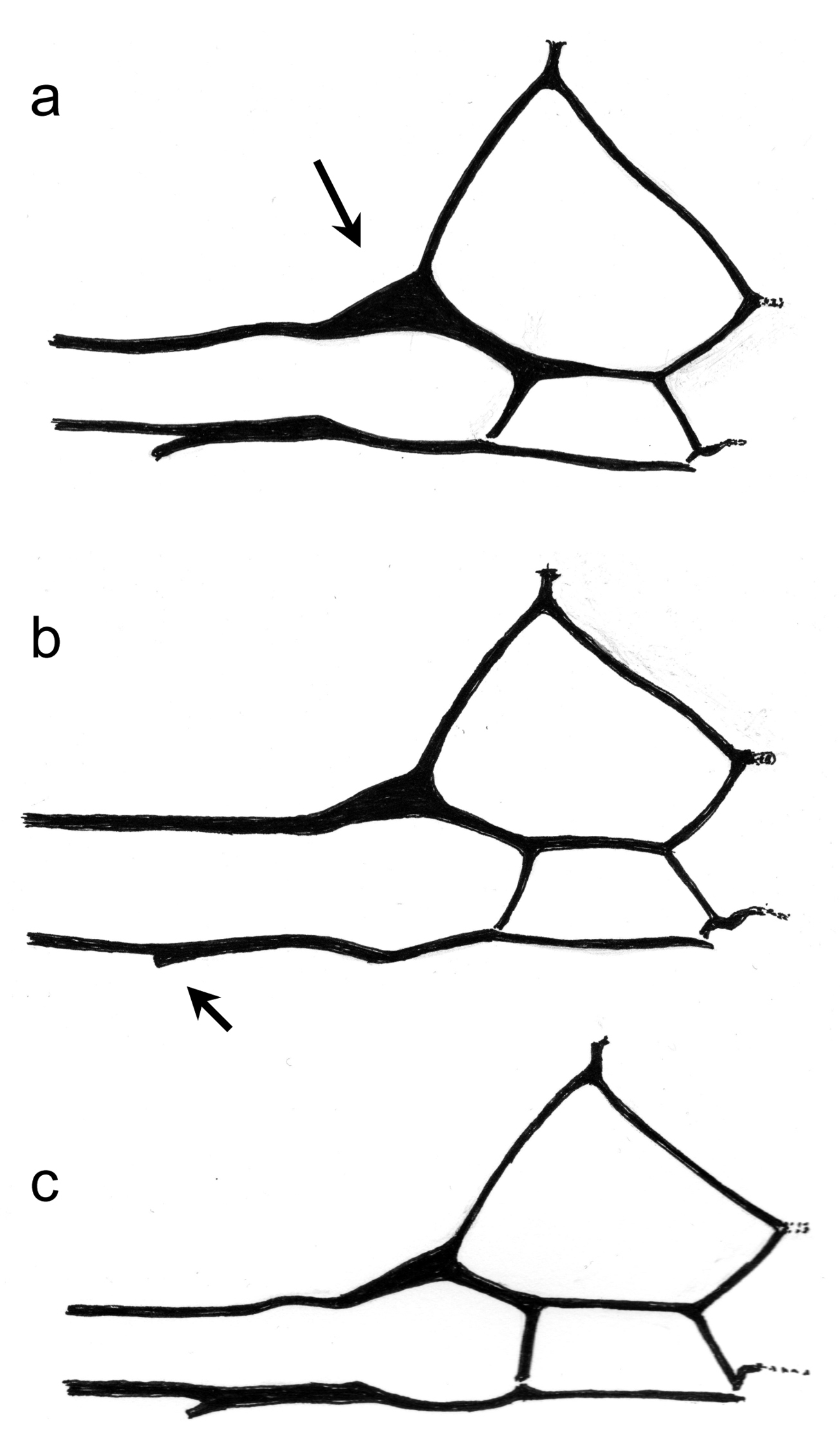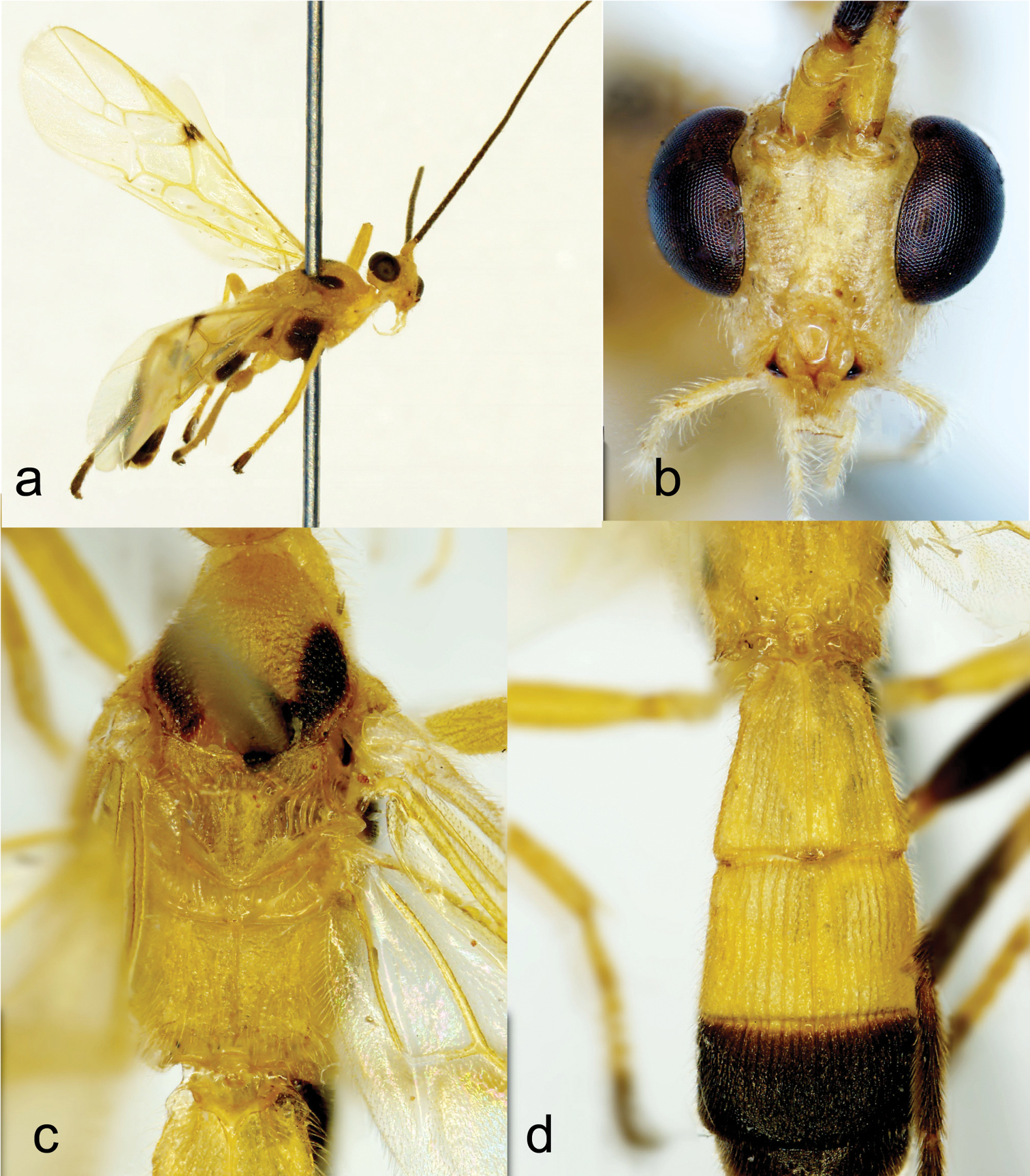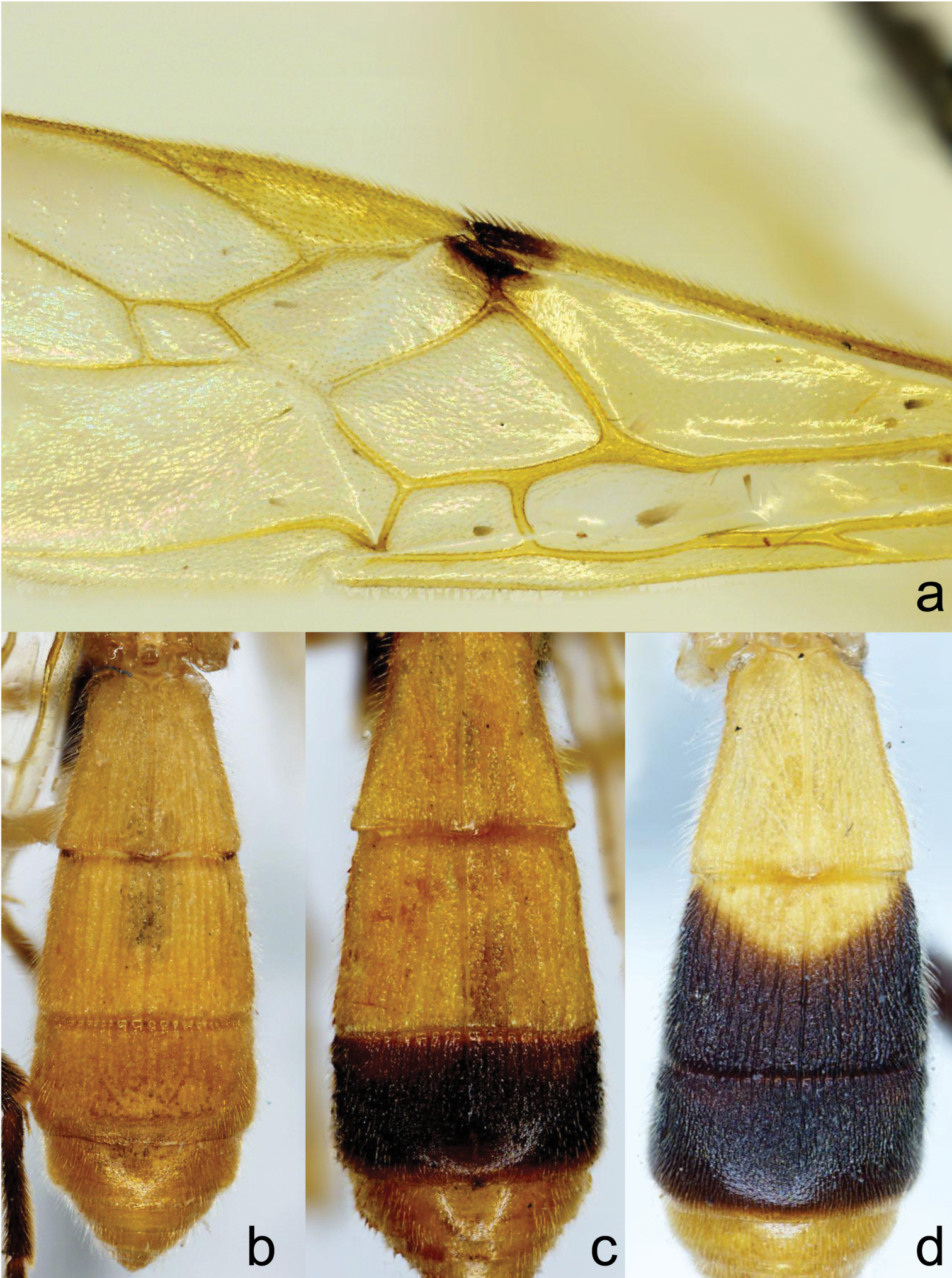






(C) 2011 Buntika Areekul Butcher. This is an open access article distributed under the terms of the Creative Commons Attribution License, which permits unrestricted use, distribution, and reproduction in any medium, provided the original author and source are credited.
For reference, use of the paginated PDF or printed version of this article is recommended.
Three new species of Asian Aleiodes are described and illustrated: Aleiodes spurivena sp. n. from Vietnam, Thailand, Nepal and India; Aleiodes spurivenaduplus sp. n. from Vietnam; Aleiodes spurivenatriplus from Western Malaysia. The first two of these are differentiated based on the bar-coding, 5’ region of the cytochrome oxidase 1 gene. All three are morphologically extremely uniform and can be recognised from other Aleiodes species by the presence of a reclivous spur arising from fore wing vein 1–1A.
Aleiodini , Oriental, cryptic species, colour variation
During revision of the species of the rogadine braconid wasp genus Aleiodes Wesmael formerly classified in the genus Hemigyroneuron (Areekul Butcher & Quicke, 2011), we encountered a number of superficially similar specimens from India, Nepal, Thailand, Vietnam and peninsular Malaysia, that represent an easily recognised, previously undescribed species group. The specimens are large and brightly coloured yellow and black. Specimens collectively show marked differences in colour pattern, but are morphologically very difficult to distinguish. We have obtained DNA sequence data for four of the specimens (all from Vietnam) that indicate the presence of two species differing only slightly in wing venation. Based on morphology alone, one of these appears to be widespread in mainland Asia. Here we describe this new species group to include these two species along with a third from Malaysia that displays slightly more derived wing venation and darker coloration. Based on limited collecting evidence, we suspect much of the colour variation is intraspecific.
Terminology follows van Achterberg (1996) repeated in
Occipital carina complete. Propodeum with distinct medio-lateral angulations and with more or less complete mid-longitudinal carina. Fore wing vein 1-A with a posterior short to long spur; distal 0.7 or more of subbasal cell glabrous (except ventrally narrowly along anterior margin) and distally swollen but lacking sclerome; junction of veins M+CU, 1-CU1 and 1-M moderately to very strongly swollen; subdiscal cell evenly setose; 2nd submarginal cell short and trapezoidal. Hind wing with vein r present as an oblique sclerotized line running at least a third of width of marginal cell. Apex of hind tibia with well-developed comb of specialised flattened setae on medial and ventral faces. Claws with strong pecten of approximately 12 teeth nearly reaching base of claw. Male without median tergal gland pore on tergites 4–6.
Key to the species of the Aleiodes spurivena sp. n. group| 1 | Forewing veins M+CU and 1-CU1 strongly swollen at junction with 1-M, vein M+CU narrowed and distinctly sinuate before the swelling (Fig. 1a); hind femur beyond trochantellus and hind tibia entirely black | Aleiodes spurivenatriplus sp. n. |
| – | Forewing veins M+CU and 1-CU1 weakly swollen at junction with 1-M, vein M+CU not distinctly sinuate before the swelling (Figs 1b, c); hind femur black with apex yellow, hind tibia yellow on at least basal third (Fig. 2) | 2 |
| 2 | Fore wing vein 1-CU1 (measured between middles of its swollen junctions) less than 0.6 × length of 2-CU1 (Fig. 1b); spur on fore wing vein 1-A tubular and reaching close to posterior margin of wing (Fig. 1b) | Aleiodes spurivena sp. n. |
| – | Fore wing vein 1-CU1 (measured between middles of its swollen junctions) 0.9 × length of 2-CU1 (Fig. 1c); spur on fore wing vein 1-A short, not reaching beyond middle of anal cell (Fig. 1c) | Aleiodes spurivenaduplus sp. n. |
urn:lsid:zoobank.org:act:05393EB9-AF1A-4D9A-B658-A30A05672DA3
http://species-id.net/wiki/Aleiodes_spurivena
Figs 1b, 2, 3“VIETNAM, Vihn Phu Prov., Thung Cuu, 30 km S of Than Son, 10-16.XI.1999, 20.59 N 105.08 E, 300m R. de Jong at light VN 99-8 RMNH 2000”, “BCLDQ0003” (RMNH).
Paratypes. VIETNAM: 2 females, Vihn Phu Province, Thung Cuu, (DNA vouchers BF00928, BF00932) (RMNH). THAILAND: 2 females, S. Thailand, 7 km N of Ranong, Ch 9 TV relay stn., 25–29.xi.1991, 350–500m, I.J. Kitching & a. M. Cotton (BMNH); 1 female, Chiang Mai, Doi Suthap, 1440m, 1983 (BMNH). NEPAL: 1 female, Kathmandu, British Embassy, v.i.1984, 1350 m., M. G. Allen (BMNH). INDIA: 1 female, Assam, Nambour Forest Reserve, 29.xi.1997, Sinaer & Murzin (private collection); 1 male, United Provinces, Naini Tal., c. 500ft., 15.iv.1934, “at light”, J. A. Graham (BMNH).
Features of fore wing venation of a Aleiodes spurivenatriplus sp. n. b Aleiodes spurivena sp. n. c Aleiodes spurivenaduplus sp. n.
Cell^D montage images of holotype of Aleiodes spurivena sp. n. a habitus b face c mesosoma, dorsal view d metasoma.
Cell^D montage images of paratype Aleiodes spurivena sp. n. specimens a detail of fore wing venation b–d showing variation in metasomal colour pattern b voucher BF00928 from Vietnam c specimen from India d voucher BF00932 from Vietnam.
Bright ochreous yellow with black pattern of variable extent. Minimally with flagellum, stemmaticum, metasomal tergite 4, hind coxa largely, hind femur medially, hind tibia apically, and hind tarsus black. In darker specimens black or dark brown marks occur on lateral lobes of mesoscutum, mesopleuron, propodeum antero-laterally, and metasomal tergites 2–4. Wings pale yellow with yellow to brown yellow venation and with fore wing parastigma and apex of C+SC+R black.
The variation in coloration is quite large, however, we are inclined to think all the above specimens are conspecific because of the lack of any apparent morphological distinction, and because two of the most extreme extents of colour variation Fig. 3b versus Fig. 3d, were collected at the same site and on the same occasion. The specimen from India most closely resembles the holotype except that it has metasomal tergite 4 brown yellow instead of black.
urn:lsid:zoobank.org:act:5B0D35F2-0ADB-41BA-A111-CACCC0800ABE
http://species-id.net/wiki/Aleiodes_spurivenaduplus
Fig. 1c“C. VIETNAM: Thua Thien Hué, Phong Dién N.R. nr base-camp, 50–100 m. 24.iii.2001. at light, C. v. Achterberg RMNH01”, “ BCLDQ01315 [DNA voucher code]” (RMNH).
Head. Antenna with 54 flagellomeres.
Coloration. Bright ochreous yellow with flagellum, stemmaticum, metasomal tergite 4, hind coxa largely, hind femur medially, hind tibia apically, and hind tarsus black. In darker specimens black or dark brown marks occur on lateral lobes of mesoscutum, mesopleuron, propodeum antero-laterally, and metasomal tergites 2–4. Wings pale yellow with yellow to brown yellow venation and with fore wing parastigma and apex of C+SC+R black.
Differs from the three other sequenced Vietnamese specimens (Aleiodes spurivena sp. nov) for which CO1 sequences of more than 500 base pairs were obtained at 3 positions, each corresponding to a 3rd codon position (Table 1).
Differentiating cytochrome oxidase 1 bases for two new species. Positions are numbered according to position in the Drosophila yakuba sequence (
| CO1 variable positions | |||
|---|---|---|---|
| 1631 | 1827 | 1875 | |
| Aleiodes spurivena sp. n. (vouchers: BCLDQ00003, GenBank JF962592; BF00928, GenBank JF903065; BF00932, GenBank JF90306) | T | A | C |
| Aleiodes spurivenaduplus sp. n. (voucher/holotype: BCLDQ01315; GenBank HQ551252) | C | G | T |
urn:lsid:zoobank.org:act:766D5DBF-D67F-463A-81C8-F7F3DD334931
http://species-id.net/wiki/Aleiodes_spurivenatriplus
Fig. 1a“MALAY PENIN: Selangor, Bukit Kutu, 3500 ft 11.9.1929, H. M. Pendlebury”, “Ex F.M.S. Museum. B.M. 1955–354” (BMNH)
Dark ochreous yellow [though coloration may have changed due to age of specimen] with black flagellum, stemmaticum, marks occur on lateral lobes of mesoscutum, mesopleuron, spot on metapleuron, metasomal tergite 2 except for triangular basal zone, tergites 3–4, hind leg except for trochanter and trochantellus. Wings pale yellow with yellow to brown yellow venation and with fore wing parastigma and apex of C+SC+R black.
We are very grateful to Kees van Achterberg (Naturalis Museum, Leiden) for the load of interesting Vietnamese material he collected. The Animal Systematic Research Unit and Integrated Ecology Lab, Department of Biology, Faculty of Science, Chulalongkorn University kindly allowed use of their Cell^D® imaging facility. This work was partly supported by BRT (R152126) and a Chulalongkorn University Centenary Academic Development Project grant to BAB.


